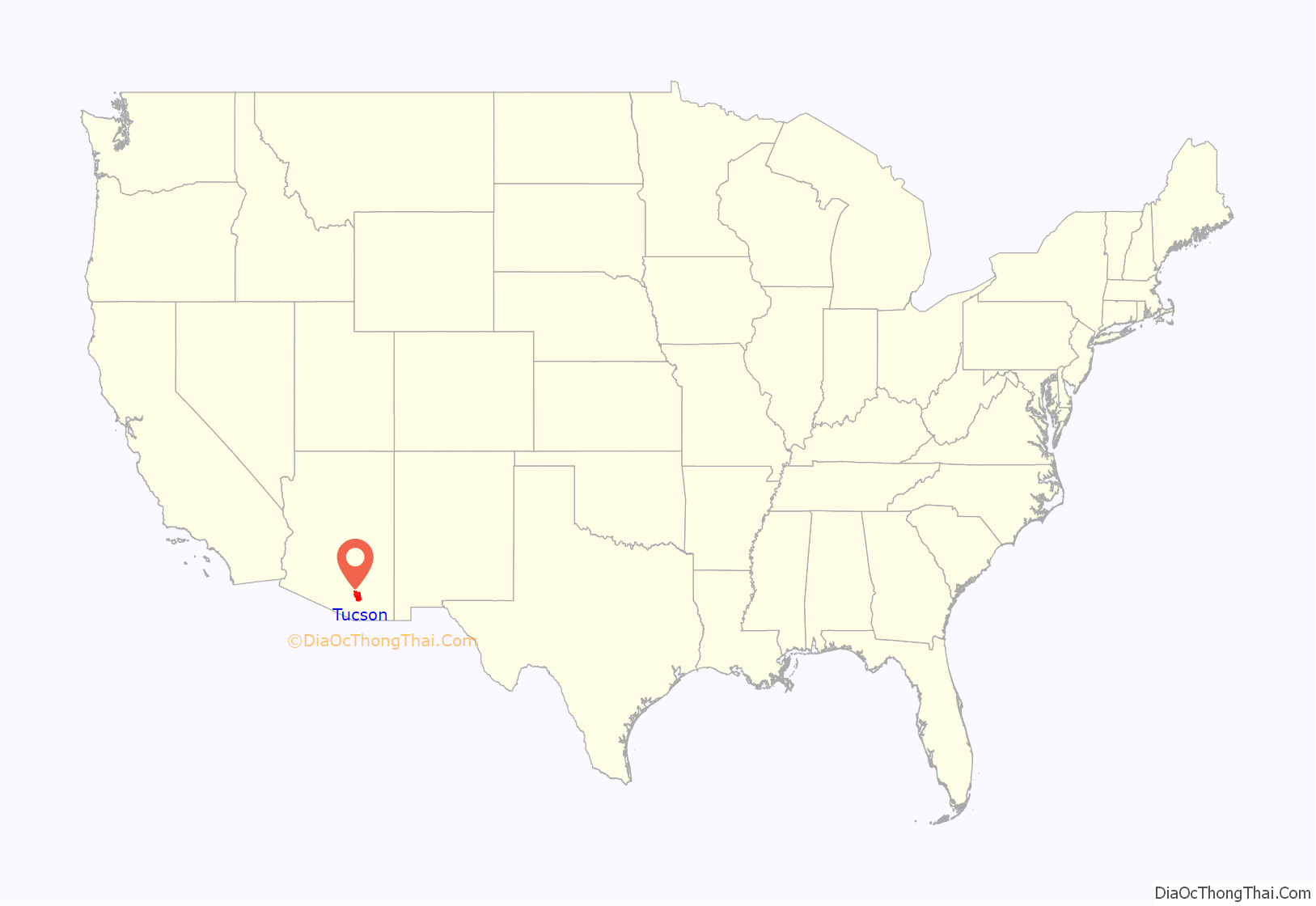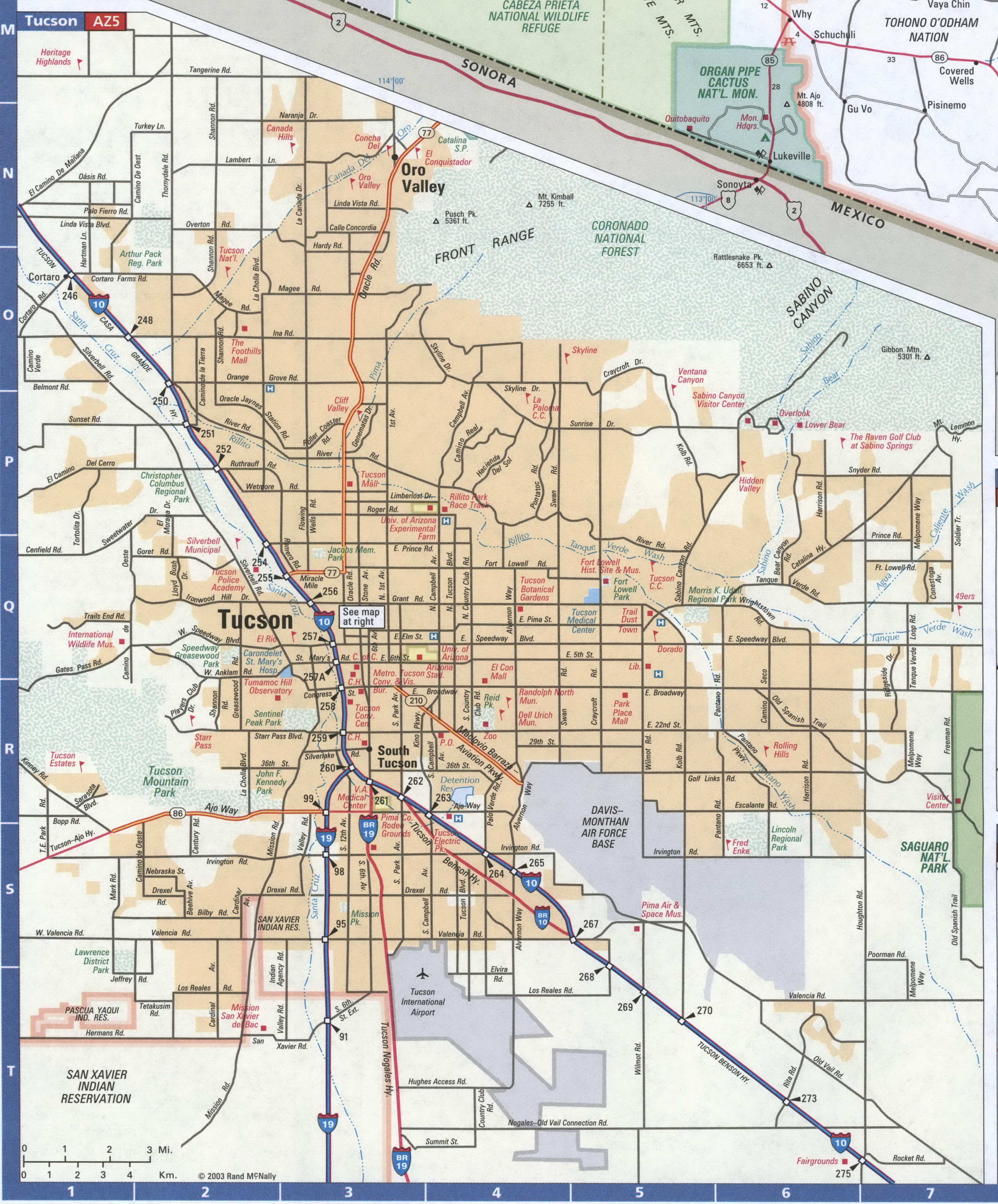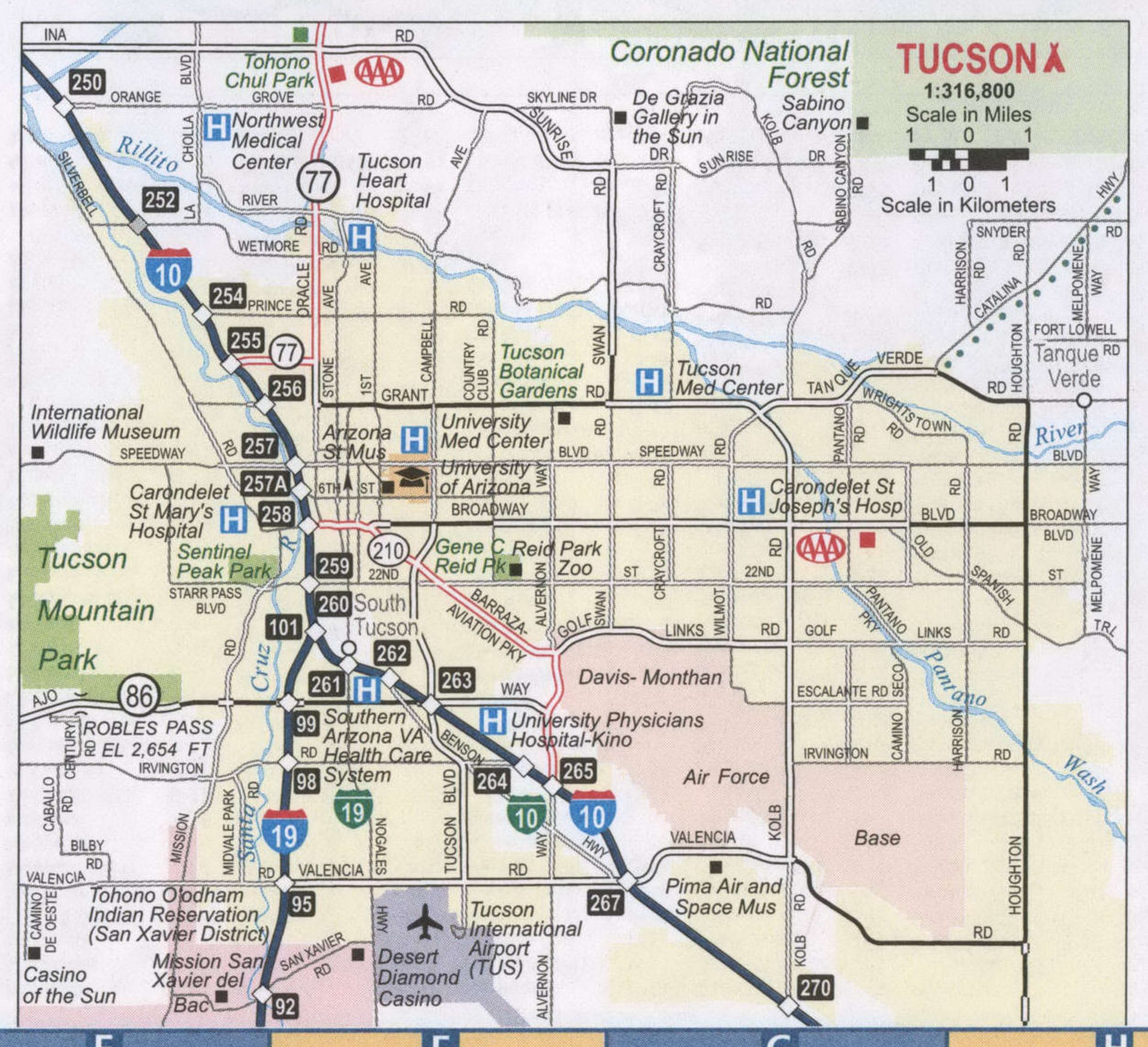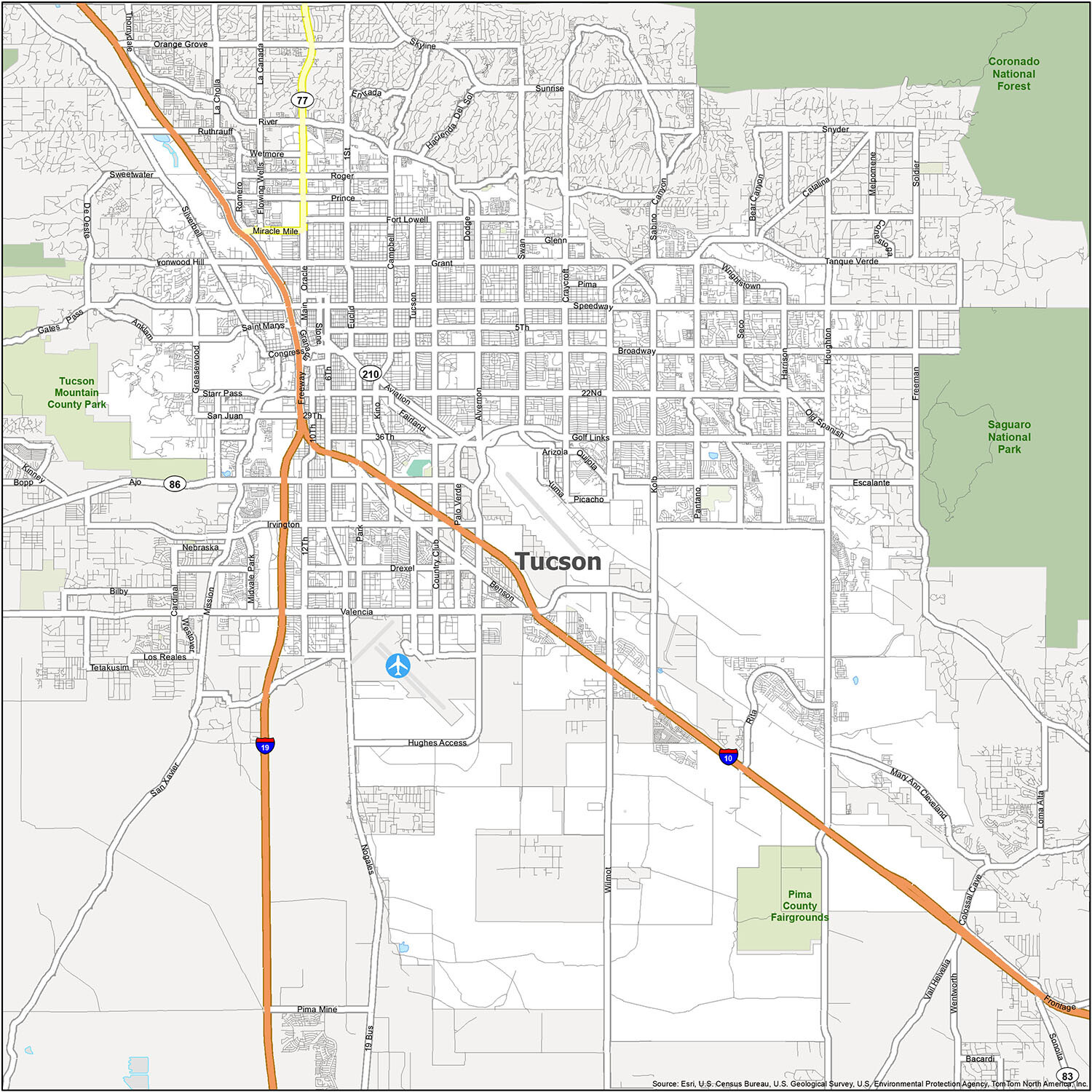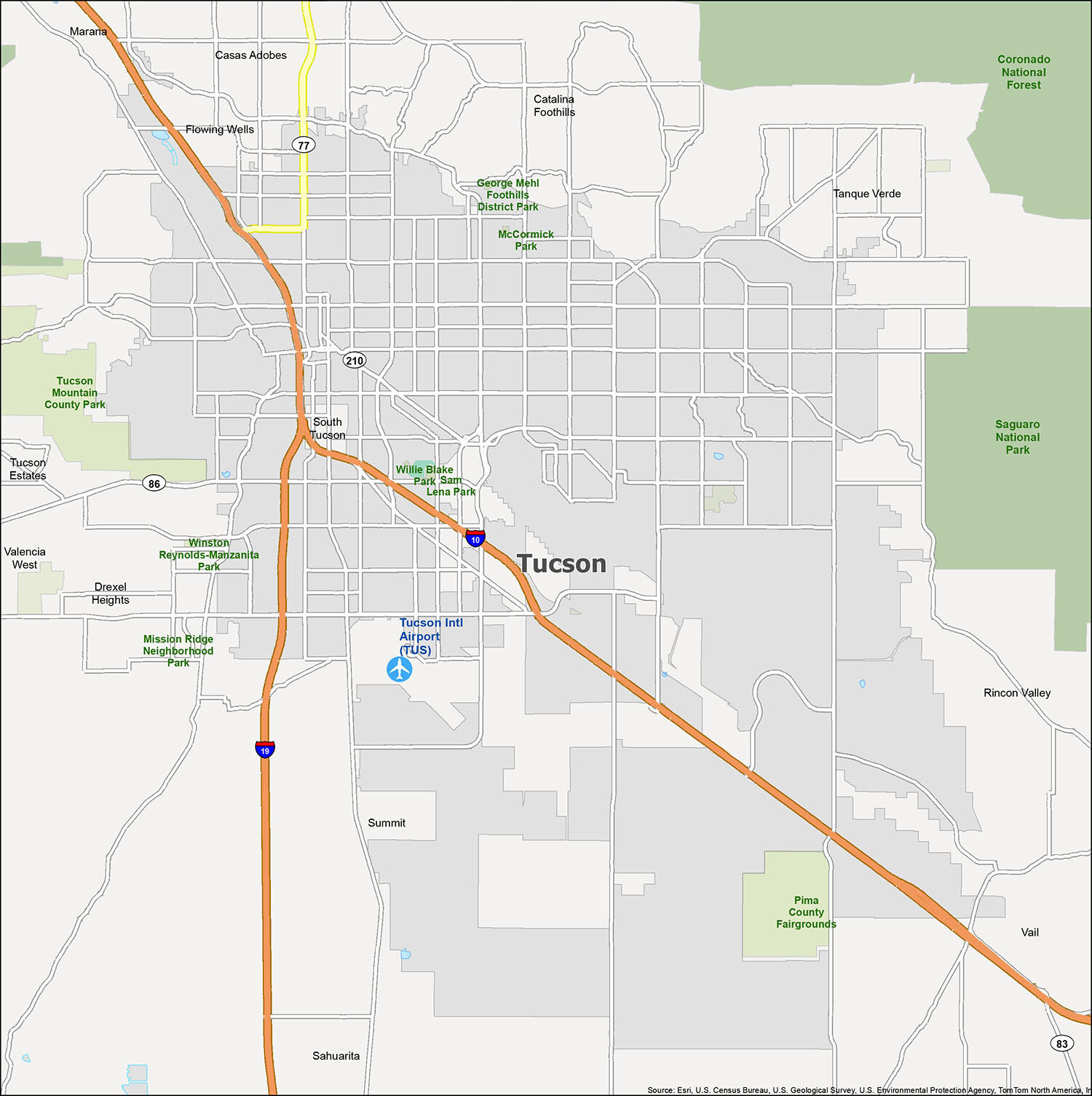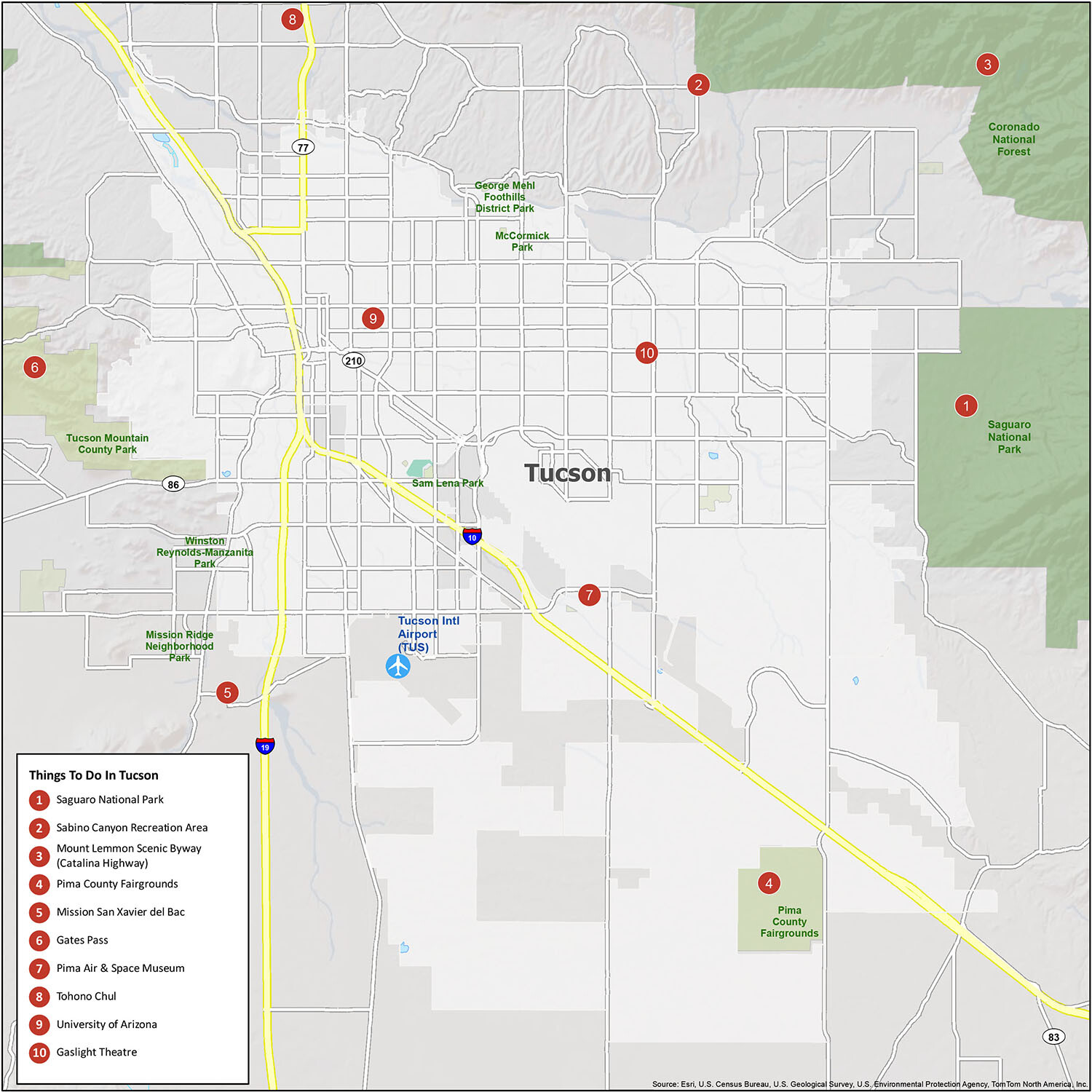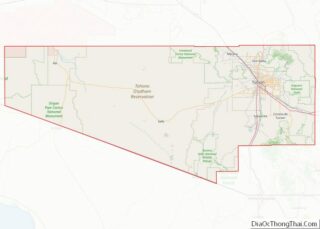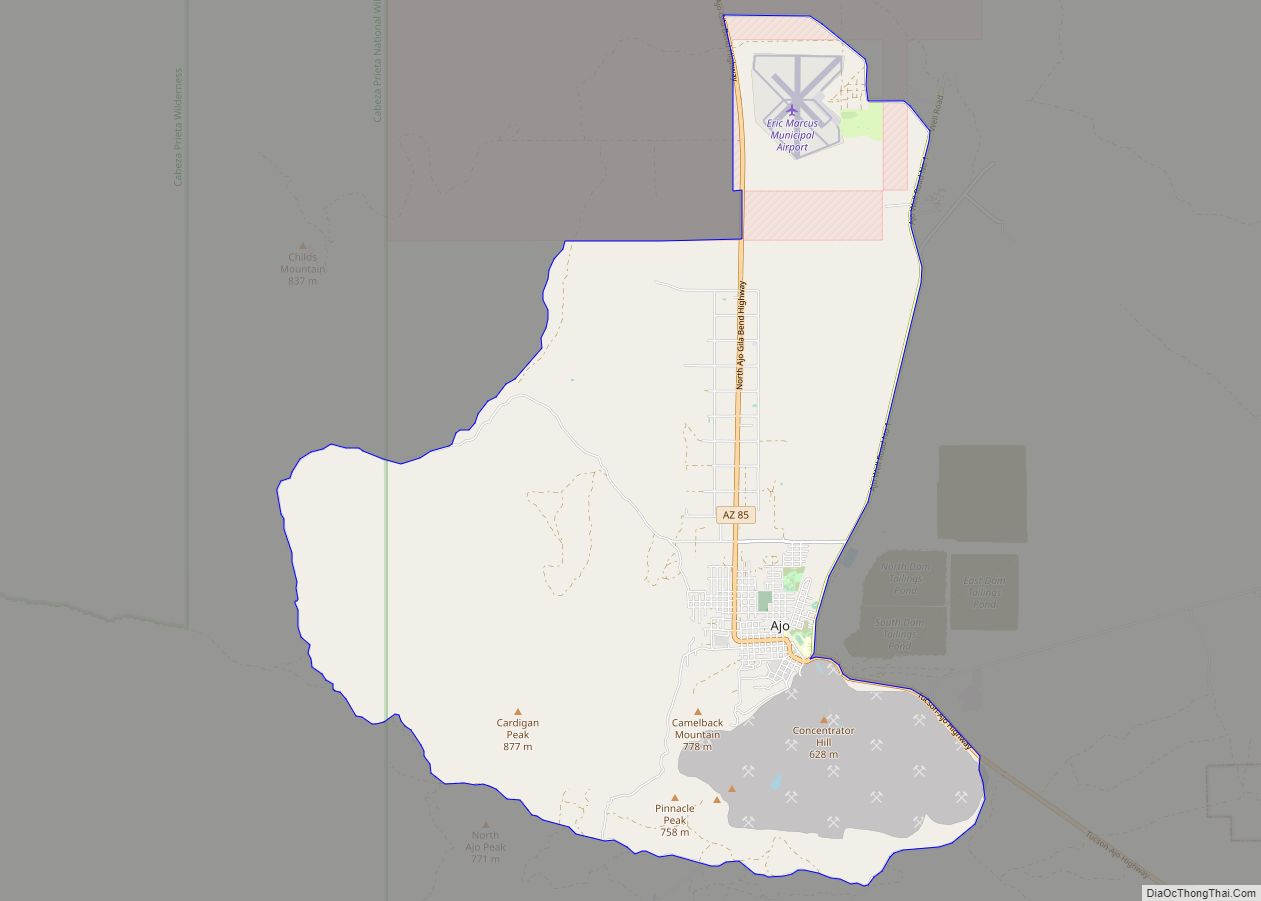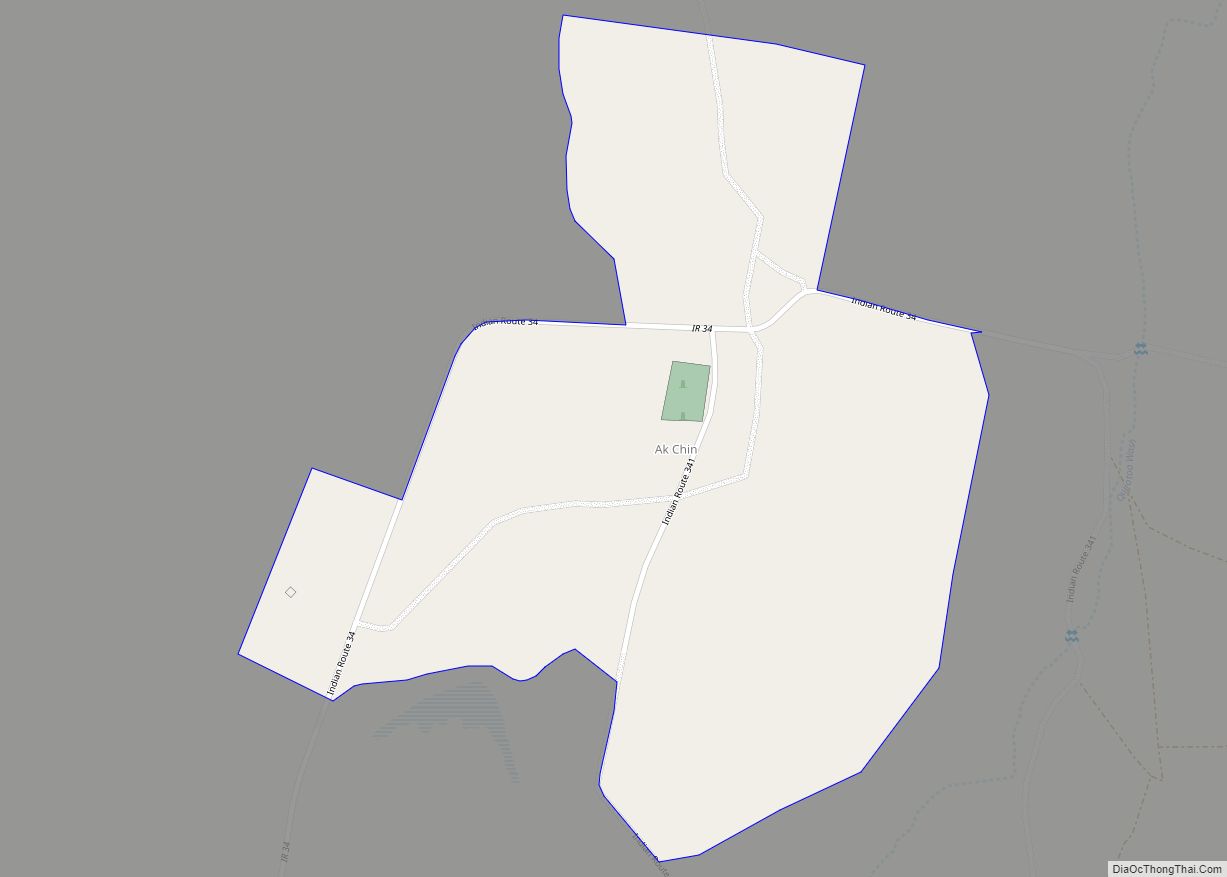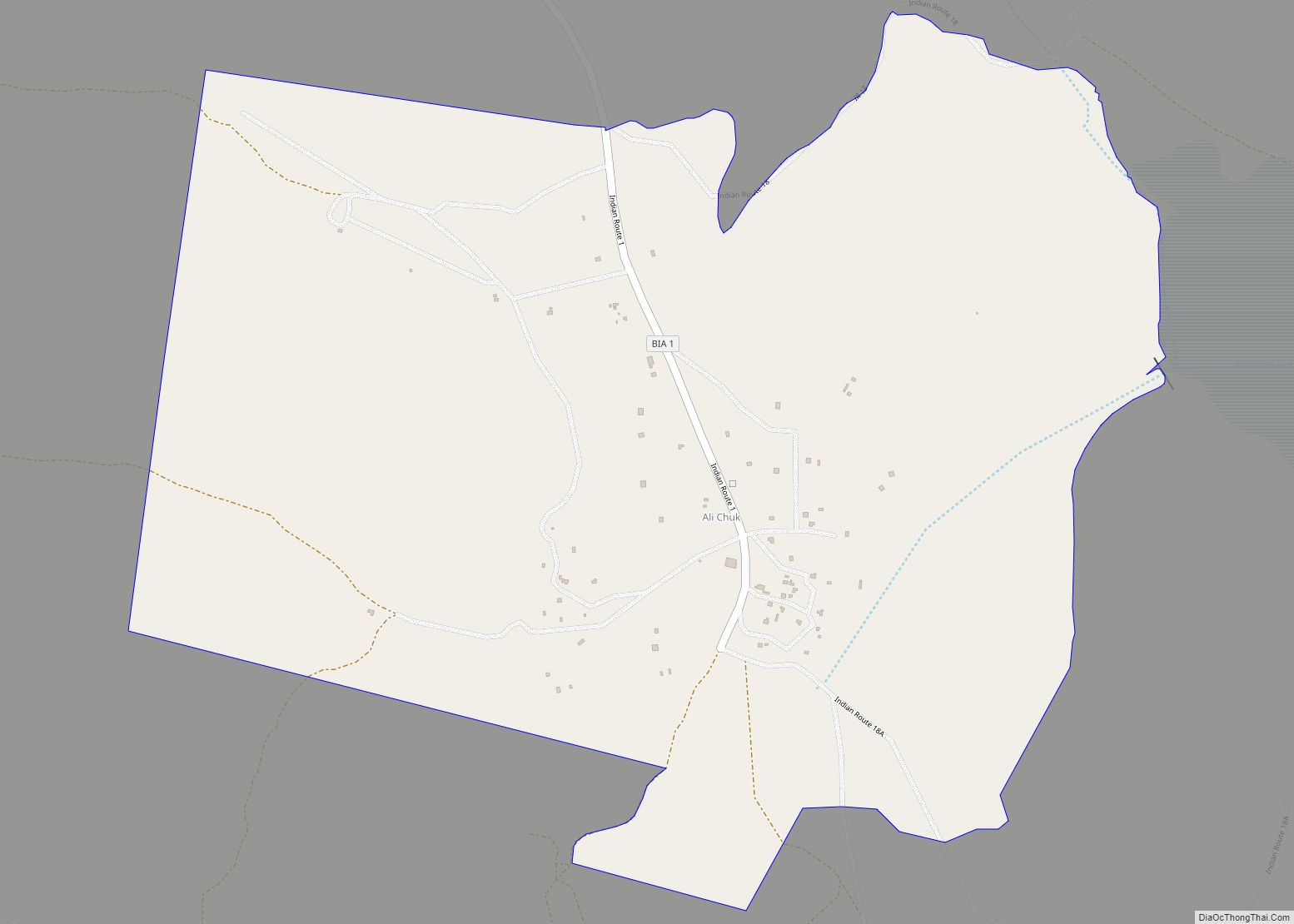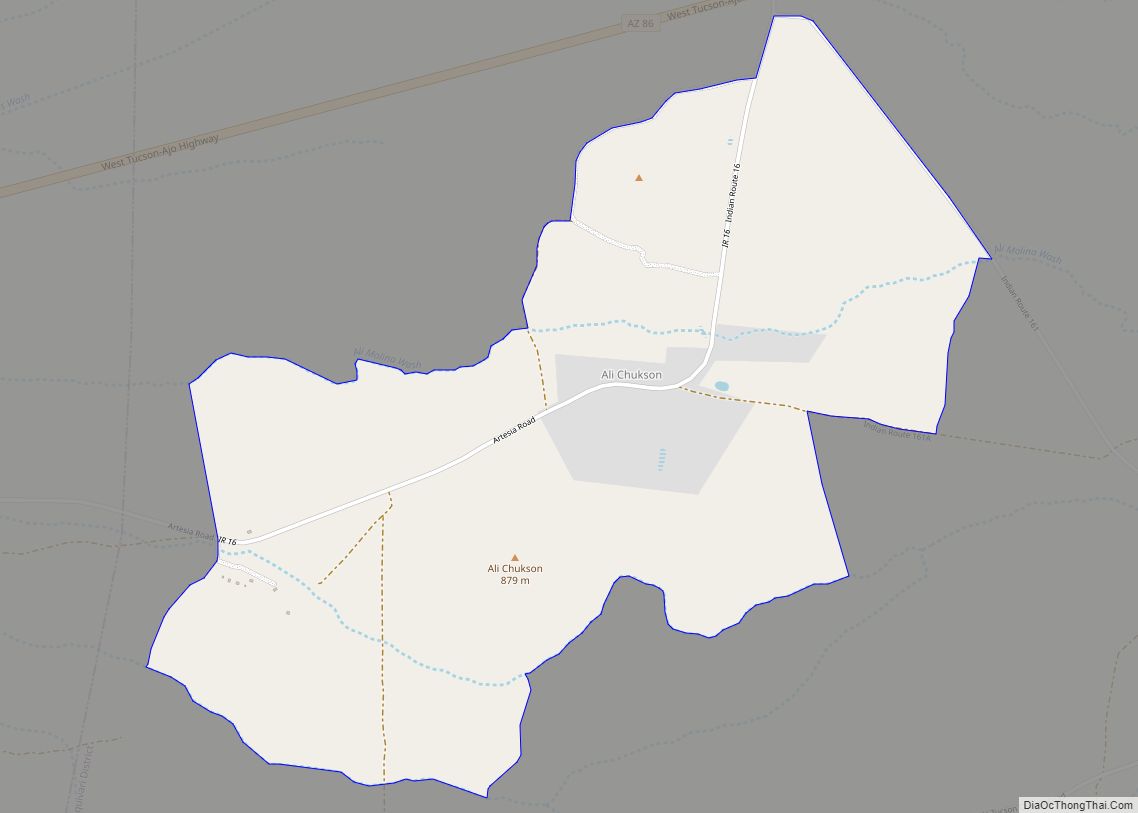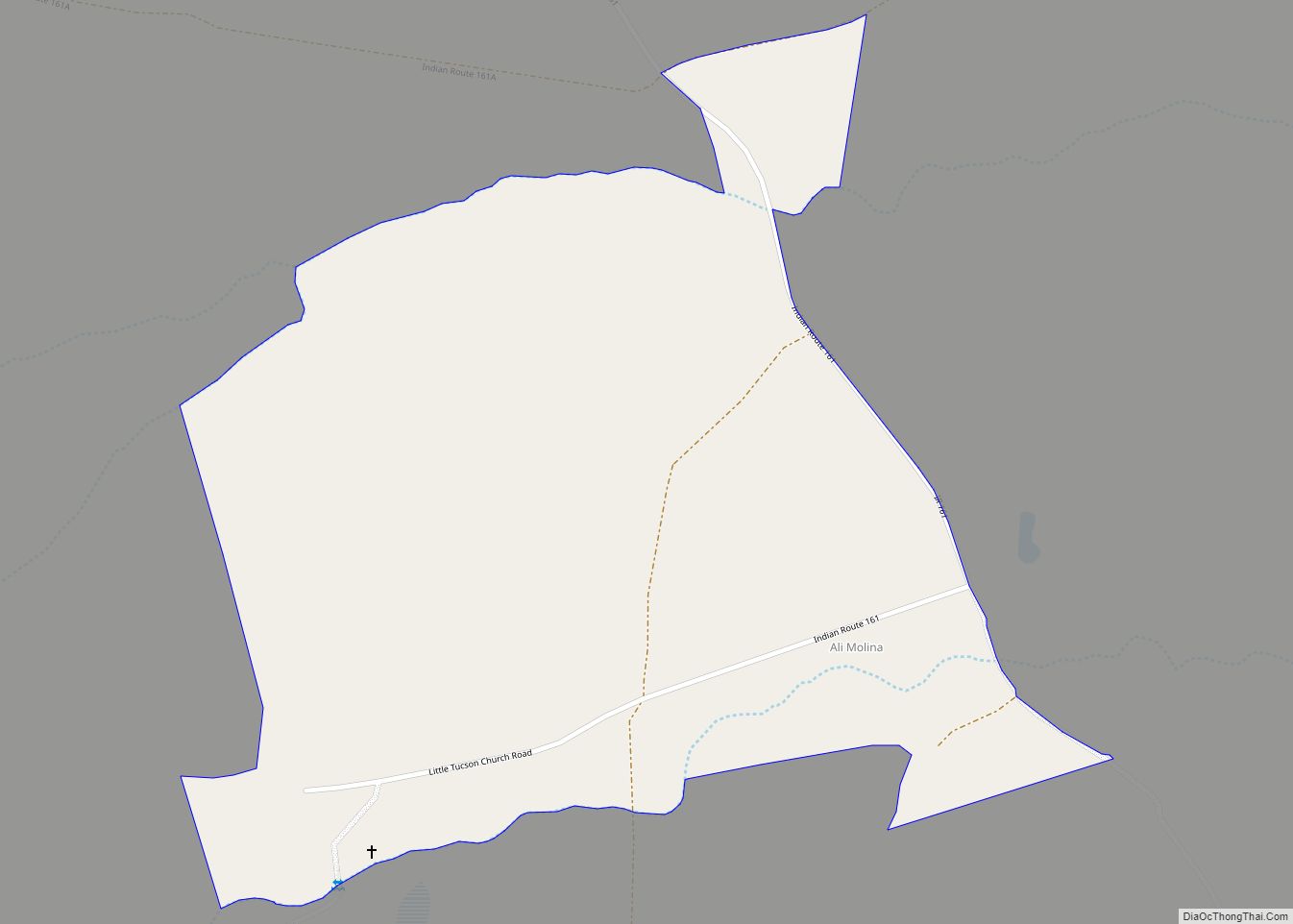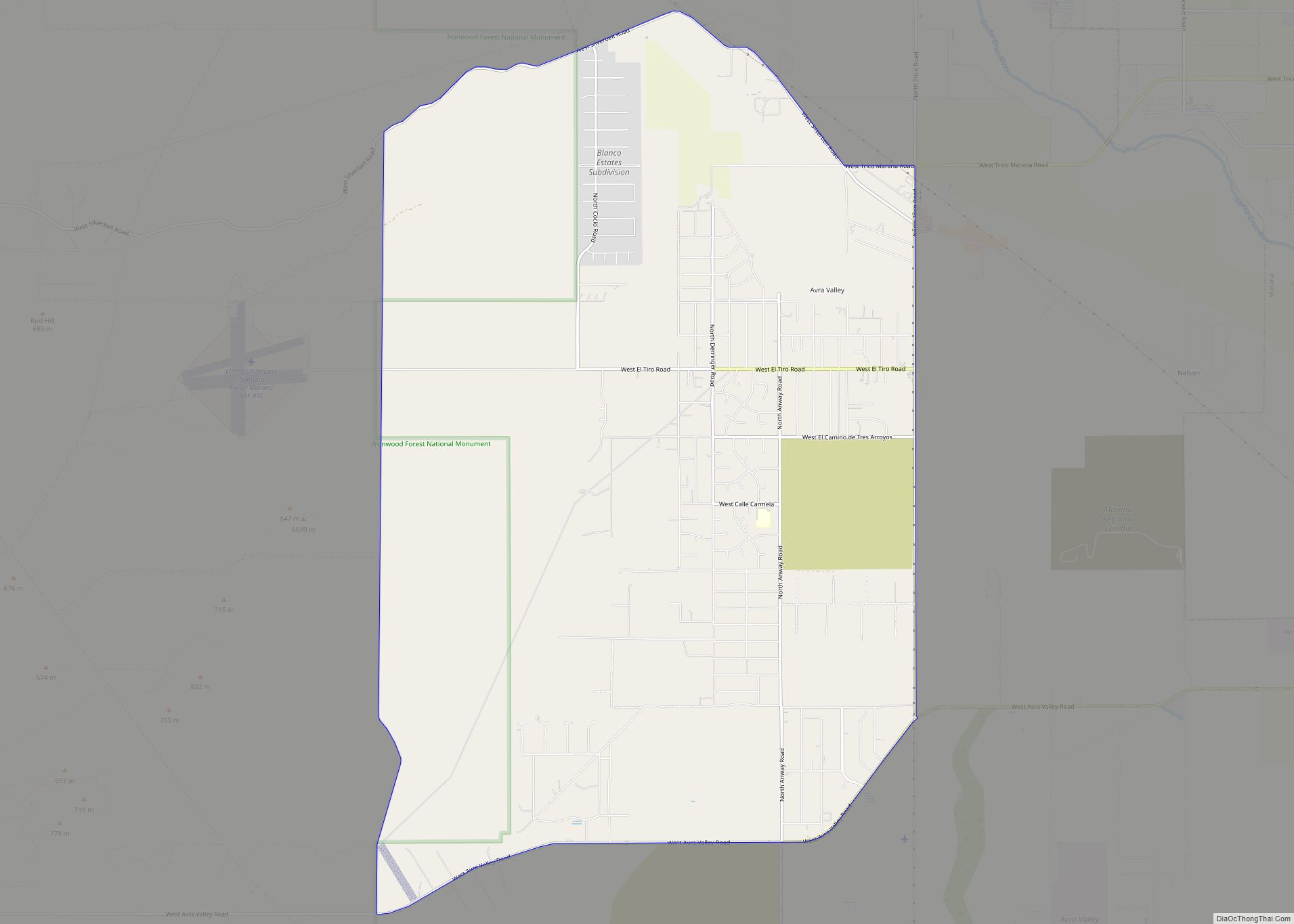Tucson (/ˈtuːsɒn/; TOO-saun; Spanish: Tucson, O’odham: Cuk-Ṣon) is a city in and the county seat of Pima County, Arizona, United States, and is home to the University of Arizona. It is the second-largest city in Arizona behind Phoenix, with a population of 542,629 in the 2020 United States census, while the population of the entire Tucson metropolitan statistical area (MSA) is 1,043,433. The Tucson MSA forms part of the larger Tucson-Nogales combined statistical area. Both Tucson and Phoenix anchor the Arizona Sun Corridor. The city is 108 miles (174 km) southeast of Phoenix and 60 mi (97 km) north of the United States–Mexico border. Tucson is the 34th-largest city and the 53rd-largest metropolitan area in the United States (2014).
Major incorporated suburbs of Tucson include Oro Valley and Marana northwest of the city, Sahuarita south of the city, and South Tucson in an enclave south of downtown. Communities in the vicinity of Tucson (some within or overlapping the city limits) include Casas Adobes, Catalina Foothills, Flowing Wells, Midvale Park, Tanque Verde, Tortolita, and Vail. Towns outside the Tucson metropolitan area include Benson to the southeast, Catalina and Oracle to the north, and Green Valley to the south.
Tucson was founded as a military fort by the Spanish when Hugo O’Conor authorized the construction of Presidio San Agustín del Tucsón in 1775. It was included in the state of Sonora after Mexico gained independence from the Spanish Empire in 1821. The United States acquired a 29,670 square miles (76,840 km) region of present-day southern Arizona and southwestern New Mexico from Mexico under the Gadsden Purchase in 1853. Tucson served as the capital of the Arizona Territory from 1867 to 1877. Tucson was Arizona’s largest city by population during the territorial period and early statehood, until it was surpassed by Phoenix by 1920. Nevertheless, its population growth remained strong during the late 20th century. Tucson was the first American city to be designated a “City of Gastronomy” by UNESCO in 2015.
The Spanish name of the city, Tucsóncode: spa promoted to code: es (Spanish pronunciation: [tuɣˈson]), is derived from the O’odham Cuk Ṣon (Uto-Aztecan pronunciation: [tʃʊk ʂɔːn]), meaning “(at the) base of the black [hill]”, a reference to a basalt-covered hill now known as Sentinel Peak. Tucson is sometimes referred to as the Old Pueblo and Optics Valley, the latter referring to its optical science and telescopes known worldwide.
| Name: | Tucson city |
|---|---|
| LSAD Code: | 25 |
| LSAD Description: | city (suffix) |
| State: | Arizona |
| County: | Pima County |
| Founded: | August 20, 1775 |
| Incorporated: | February 7, 1877 |
| Elevation: | 2,389 ft (728 m) |
| Land Area: | 241.01 sq mi (624.22 km²) |
| Water Area: | 0.32 sq mi (0.82 km²) |
| Population Density: | 2,251.44/sq mi (869.29/km²) |
| Area code: | 520 |
| FIPS code: | 0477000 |
| GNISfeature ID: | 43534 |
| Website: | tucsonaz.gov |
Tucson Map Collection
Home to the prestigious University of Arizona, Tucson has a thriving arts and culture scene, as well as a host of shopping, dining, and entertainment options. Located in the south region of Arizona, Tucson sits in the Sonoran Desert. This Tucson map collection highlights the city known for its deserts, parks, and rich history. It’s not just a single map of Tucson, but instead, it features several maps with roads, reference information, and things to do.
Download and print any from the Tucson map collection to help you navigate through the Arizona desert city. But first, explore the city with this interactive map provided by Google Maps.
Online Interactive Map
Click on ![]() to view map in "full screen" mode.
to view map in "full screen" mode.
Discover the best of what Tucson has to offer with this interactive map. This map will show you the best food, attractions, and shopping that Tucson Arizona has to offer. Tour Tucson Arizona before you go with this interactive map and check out the city in the desert.
Tucson location map. Where is Tucson city?
History
The Tucson area was probably first visited by Paleo-Indians, who were known to have been in southern Arizona about 12,000 years ago. Recent archaeological excavations near the Santa Cruz River found a village site dating from 2100 BC. The floodplain of the Santa Cruz River was extensively farmed during the Early Agricultural Period, c. 1200 BC to AD 150. These people hunted, gathered wild plants and nuts, and ate corn, beans, and other crops grown using irrigation canals they constructed.
The Early Ceramic period occupation of Tucson had the first extensive use of pottery vessels for cooking and storage. The groups designated as the Hohokam lived in the area from AD 600 to 1450 and are known for their vast irrigation canal systems and their red-on-brown pottery.
Spanish Jesuit missionary Eusebio Francisco Kino first visited the Santa Cruz River valley in 1692. He founded the Mission San Xavier del Bac in 1700, about 7 mi (11 km) upstream from the site of the settlement of Tucson. A separate Convento settlement was founded downstream along the Santa Cruz River, near the base of what is now known as “A” mountain. Hugo Oconór (Hugo O’Conor), the founding father of the city of Tucson, Arizona, authorized the construction of a military fort in that location, Presidio San Agustín del Tucsón, on August 20, 1775 (the present downtown Pima County Courthouse was built near this site). During the Spanish period of the presidio, attacks such as the Second Battle of Tucson were repeatedly mounted by the Apache. Eventually, the town came to be called Tucsón, a Spanish version of the O’odham word for the area. It was included in the state of Sonora after Mexico gained independence from the Kingdom of Spain and its Spanish Empire in 1821.
During the Mexican–American War in 1846–1848, Tucsón was captured by Philip St. George Cooke with the Mormon Battalion, but it soon returned to Mexican control as Cooke proceeded to the west, establishing Cooke’s Wagon Road to California. Tucsón was not included in the Mexican Cession to the United States following the war. Cooke’s road through Tucsón became one of the important routes into California during the California Gold Rush of 1849.
The US acquired those portions of (modern day) Arizona that lay south of the Gila River by treaty from Mexico in the Gadsden Purchase on June 8, 1854. Under this treaty and purchase, Tucsón became a part of the United States of America. The American military did not formally take over control until March 1856. In time, the name of the town became standardized in English in its current form, where the stress is on the first syllable, the “u” is long, and the “c” is silent.
In 1857, Tucson was established as a stage station on the San Antonio-San Diego Mail Line. In 1858, it became third division headquarters of the Butterfield Overland Mail and operated until the line was shut down in March 1861. The Overland Mail Corporation attempted to continue running, but following the Bascom Affair, devastating Apache attacks on the stations and coaches ended operations in August 1861.
Tucson was incorporated in 1877, making it the oldest incorporated city in Arizona.
From 1877 to 1878, the area suffered a rash of stagecoach robberies. Most notable were the two holdups committed by masked road agent William Whitney Brazelton. Brazelton held up two stages in the summer of 1878 near Point of Mountain Station, about 17 mi (27 km) northwest of Tucson. John Clum, of Tombstone, Arizona, fame, was one of the passengers. Pima County Sheriff Charles A. Shibell and his citizen posse killed Brazelton on August 19, 1878, in a mesquite bosque along the Santa Cruz River 3 miles (5 km) south of Tucson. Brazelton had been suspected of highway robbery in the Tucson area, the Prescott region, and the Silver City, New Mexico area. Because of the crimes and threats to his business, John J. Valentine, Sr. of Wells, Fargo & Co. had sent Bob Paul, a special agent and a future Pima County sheriff, to investigate. The US Army established Fort Lowell, then east of Tucson, to help protect settlers and travelers from Apache attacks.
In 1882, Morgan Earp was fatally shot, in what was later referred to in the press as the “Earp-Clanton Tragedy”. Marietta Spence, wife of Pete Spence, one of the Cochise County Cowboys, testified at the coroner’s inquest on Earp’s killing and implicated Frank Stilwell in the murder. The coroner’s jury concluded Pete Spence, Stilwell, Frederick Bode, and Florentino “Indian Charlie” Cruz were the prime suspects in the assassination of Morgan Earp.
Deputy U.S. Marshal Wyatt Earp gathered a few trusted friends and accompanied Virgil Earp and his family as they traveled to Benson to take a train to California. They found Stilwell apparently lying in wait for Virgil Earp at the Tucson station and killed him on the tracks. After killing Stilwell, Wyatt deputized others and conducted a vendetta, killing three more cowboys over the next few days before leaving the territory.
Jim Leavy had built a reputation of having fought in at least 16 gunfights. On June 5, 1882, Leavy had an argument with faro dealer John Murphy in Tucson. The two agreed to have a duel on the Mexican border, but after hearing of Leavy’s exploits as a gunfighter, Murphy decided to ambush Leavy, instead. Together with two of his friends, Murphy ambushed Leavy as he was leaving the Palace Hotel, killing him. According to Wright, the three co-defendants in Leavy’s murder later escaped from the Pima County Jail, but were later recaptured. Murphy and Gibson were found in Fenner, California, living under assumed names; they were retried for the murder before being found not guilty. Moyer was captured in Denver and sentenced to life in Yuma Territorial Prison, but was pardoned in 1888.
Post-frontier life
As other settlers tried to overcome violent frontier society, in 1885, the territorial legislature founded the University of Arizona as a land-grant college on what was overgrazed ranchland between Tucson and Fort Lowell.
In 1890, Asians made up 4.2% of the city’s population. They were predominantly Chinese men who had been recruited as workers on the railroads.
By 1900, 7,531 people lived in Tucson. By 1910, the population increased to 13,913. About this time, the U.S. Veterans Administration had begun construction of the present Veterans Hospital. The city’s clean, dry air made it a destination for many veterans who had been gassed in World War I and needed respiratory therapy. In addition, these dry and high-altitude conditions were thought to be ideal for the treatment of tuberculosis, for which no cures were known before antibiotics were developed against it.
The city continued to grow, with the population increasing to 20,292 in 1920 and 36,818 in 1940. In 2006, the estimated population of Pima County, in which Tucson is located, passed one million, while the City of Tucson’s population was 535,000.
In 1912, Arizona was admitted as a state. This increased the number of flags that had been flown over Tucson to five: Spanish, Mexican, United States, Confederate, and the State of Arizona.
During the territorial and early statehood periods, Tucson was Arizona’s largest city and commercial center, while Phoenix was the seat of state government (beginning in 1889) and agriculture. The development of Tucson Municipal Airport increased the city’s prominence. Between 1910 and 1920, though, Phoenix surpassed Tucson in population, and has continued to outpace Tucson in growth. In recent years, both Tucson and Phoenix have had some of the highest growth rates of any jurisdiction in the United States.
Tucson Road Map
Explore Tucson Arizona with this road map and get to know the city like a local. Whether you are a first-time visitor or a longtime resident, it will show you all the things that make Tucson Arizona an amazing place to live. Learn about its highways and streets including Interstate Highways I-10 and I-19, US Highways 77, 86, 210, Benson Hwy, Casa Grande Hwy, Nogales Hwy, Aviation Pky, Kino Pky and Major Roads 4th Ave, 6th Ave, Ajo Way, Alvernon Way, Broadway Blvd, Business Center Dr, Campbell Ave, Congress St, Drachman St, Freeway Rd, Golf Links Rd, Grant Rd, Houghton Rd, Kolb Rd, Main Ave, Miracle Mile, Oracle Rd, River Rd, Sabino Canyon Rd, Speedway Blvd, Stone Ave, Tanque Verde Rd, Thornydale Rd, Toole Ave, Tucson Blvd, Valencia Rd.
Tucson is a great place to explore and find your own adventure. Whether you’re looking for a relaxing day in the sun or a thrilling adventure in the great outdoors, Tucson has something for everyone. From the bustling downtown scene to the quiet desert trails, Tucson is full of amazing places to explore. From airports and parks to cities and towns, Tucson has it all. So why wait? Start exploring the best places in Tucson today!
10 things to do in Tucson city
Tucson, Arizona is a great place to explore and discover something new. With so many hidden gems and new experiences to choose from, you’ll never run out of things to do. Whether you’re looking for outdoor adventures or cultural attractions, this guide will help you plan your next visit to Tucson. From exploring Saguaro National Park to visiting the Pima Air & Space Museum, there’s something for everyone to enjoy.
From the majestic Saguaro National Park to the iconic Mission San Xavier del Bac, Tucson has something to offer everyone. Whether you’re looking to explore the great outdoors or experience the city’s cultural attractions, this guide will help you plan your next visit to Tucson. Discover the hidden gems of Tucson, Arizona and explore the city in a whole new way. From the Pima County Fairgrounds to the Gaslight Theatre, there’s something for everyone to enjoy.
Tucson city Satellite Map
See also
Map of Arizona State and its subdivision: Map of other states:- Alabama
- Alaska
- Arizona
- Arkansas
- California
- Colorado
- Connecticut
- Delaware
- District of Columbia
- Florida
- Georgia
- Hawaii
- Idaho
- Illinois
- Indiana
- Iowa
- Kansas
- Kentucky
- Louisiana
- Maine
- Maryland
- Massachusetts
- Michigan
- Minnesota
- Mississippi
- Missouri
- Montana
- Nebraska
- Nevada
- New Hampshire
- New Jersey
- New Mexico
- New York
- North Carolina
- North Dakota
- Ohio
- Oklahoma
- Oregon
- Pennsylvania
- Rhode Island
- South Carolina
- South Dakota
- Tennessee
- Texas
- Utah
- Vermont
- Virginia
- Washington
- West Virginia
- Wisconsin
- Wyoming
